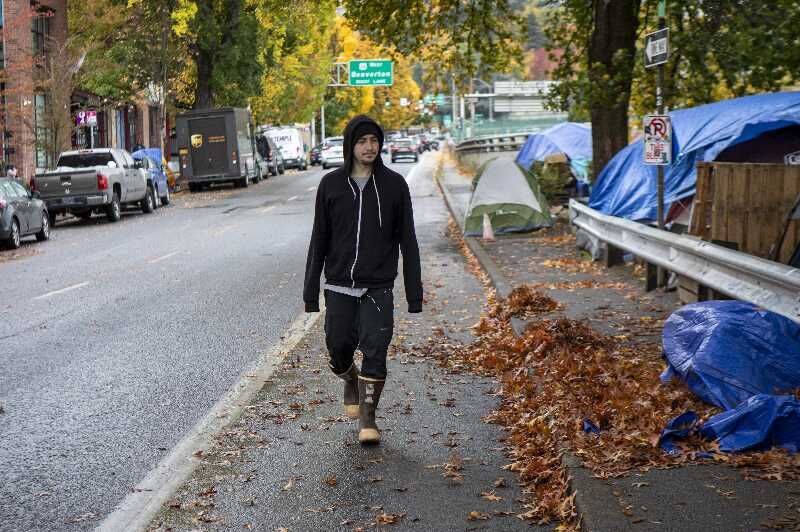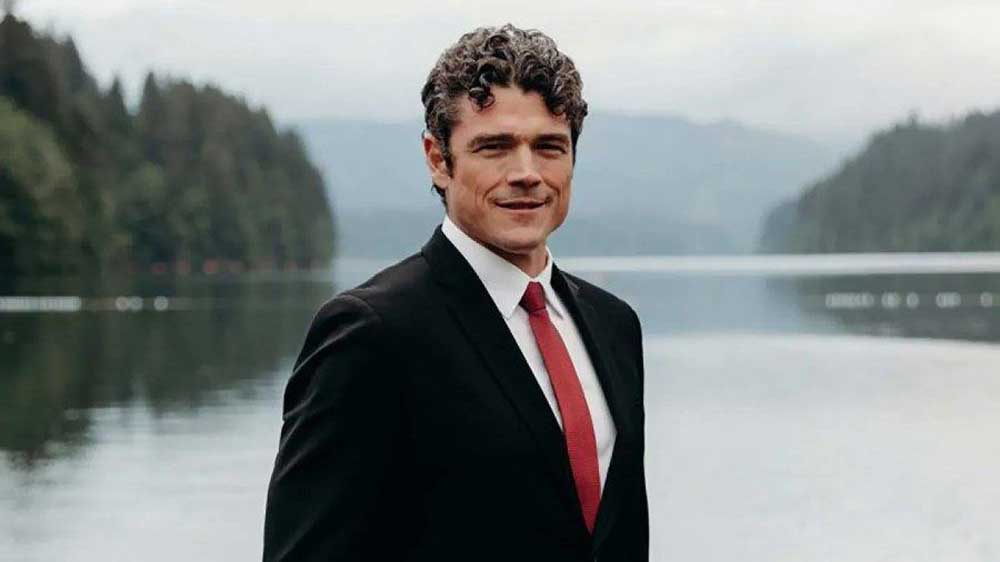Portland homeless youth band together to survive sweeps
Published 2:00 pm Wednesday, November 3, 2021

- Johnny, 24, has been homeless in Portland for about two years. Hes one of several young people living in a tent downtown in an organized camp with easy access to resources from nearby nonprofit org Outside In."
Each day, Orianna Robinson and her neighbors wake up to the buzz of cars in downtown Portland.
In August, they were fretting about how to escape an upcoming triple-digit heat wave. Now, they have to figure out how to survive the winter.
Trending
Robinson, 21, is among the more than dozen young people living in tents along a sidewalk on Southwest 13th Avenue.
Most days, it feels like they can’t catch a break. For Robinson, it’s felt like that for much of her life.
Robinson claims her family had been abusive. “I spent most of my life just trying to keep my sister safe.”
As the city scrambles to find temporary shelter for its vast unhoused population and to relocate the homeless camps that cover downtown sidewalks, some at the state level say it will do little to get young people off the streets and back on their feet.
On top of the heat, rain and cold, Robinson and her neighbors face another threat: in August, days before the triple-digit heat wave, they were warned the city of Portland was likely to sweep their camp in the coming days. That didn’t happen, but it could at any point.
“We have not posted this site for removal, but it does meet the threshold for a high health and safety risk — so it is eligible for posting,” Heather Hafer, public information officer with the city’s Office of Management and Finance told Pamplin Media Group in August. “We are also aware that there are a number of younger individuals at this site and we are working very closely with Outside In, the Multnomah County Navigation Team and Janus Youth to make sure that people have access to services and other resources.”
Trending
For Robinson, who relies on medication for her frequent seizures, relocating her tent would put her out of reach from services provided by Outside In, a nonprofit organization serving LGBTQ, homeless and other minority youth.
“We’ve always experienced different folks who camp outside our facilities, but since COVID-19, we’ve seen more folks who are stationary,” Outside In’s Youth Services Director, Brian Sexton, said.
According to the state’s Department of Human Services, Oregon has the third largest number of homeless youth in the country.
Outside In plays a key role in helping unhoused young people, offering behavioral health, health care, food, case management and housing, among other services like computer access to people ages 16 to 24. Almost everyone at the camp across from the organization’s offices is younger than 25.
Sexton said several factors can lead to young people ending up on the streets.
“There is no one reason for homelessness,” Sexton said. “There’s a myriad of reasons, a lot of them systemic. They range from mental health issues to bad luck, but really a lot of the folks we serve are on the LGBTQIA spectrum and face discrimination from their families. General poverty is another reason. Abuse, trauma.”
Sexton said many times, “people just fall into a rut and get stuck there.”
The third and fourth floors of the organization’s building on Southwest 13th Avenue are housing units. Hannah Bates is one of the residents there.
Bates, a lifelong Portlander and former Cleveland High School student, said she left home before she was financially stable, because she felt mistreated at home with her family. She was able to secure an apartment through Outside In, but tenants can only stay for a couple of years before they are asked to find their own housing. She’ll need to find a job and save up money.
“I’d much rather struggle to feed myself or have holes in my shoes,” Bates said, noting she felt like she “had to get out” of her family’s house.
Among Bates’ neighbors is a teen who’s eight-months pregnant. Her partner, who’s 25, is too old to qualify to live there. For now, he’s on the hunt for a job.
“I applied at Taco Bell,” he said, enthusiastically. Now he’s waiting for a call back, but that can be challenging for the homeless, who lack electricity to charge a cell phone. On top of that, many have lost their IDs or don’t have access to regular hygiene.
Community within the community
The row of tents along Southwest 13th Avenue is a community of young people between the ages of 17 and 24. Those who set up a tent are held to ground rules and communal expectations: no hard drugs, no fighting and no abusive behavior.
That doesn’t insulate them from external threats.
“People have been attacking the camps,” Crystal Rose, 18, said. “People were bear-maced. We just try to arm ourselves the best we can.”
Rose suspects the bear mace attack was a “personal vendetta” by someone known to those at the camps.
A week later, someone in the camp was shot with a BB gun by a motorist, others reported.
Rose has been staying in a tent at the camp since May, where she’s found comfort.
“It sucks sometimes, but the solidarity is nice,” Rose said. “I didn’t have to prove myself to anybody here.”
Like Robinson, Rose was placed with foster parents before being adopted. The gender-fluid teen left what she described as “a toxic living situation” in Newport and got transferred to a youth shelter in Corvallis. Rose had to leave the shelter after turning 18. She wants to finish high school and tried unsuccessfully to do distance-learning last year from a school-issued laptop, while living in a tent.
One young Portlander was able to beat the odds, and went from living in a tent at the youth camp for a few months, to getting a job at Amazon and making enough money to qualify for an apartment with the help of New Avenues for Youth and a rental assistance program.
Zura Benton, 20, said she was kicked out of her parents’ house in Taos, New Mexico, at 18 because she didn’t have a job. She now works as a server at a country club.
“I graduated high school with a 4.3 GPA and 36 college credits,” Benton said. “People see us as people who aren’t doing anything with their lives, but what they fail to see is the symptoms and not the cause.”
The 20-year-old made her way from New Mexico to Portland thanks to the generosity of folks who gave her a haircut, $100, a pizza and a bus ticket to Oregon.
The shelter/housing debate
As state leaders look for solutions to youth homelessness, some say the type of rental assistance program that helped Benton is needed more immediately than new shelters or pop-up housing villages.
“Rental assistance is the key to ending homelessness for folks,” Mike Savara, assistant director of homeless services with Oregon Housing and Community Services, said Friday, Oct. 29, during a statewide forum on youth homelessness. “They often need the support of housing first, in order to allow them to move forward.”
Savara said it’s difficult for unhoused people to show up and fully participate in society without their basic housing needs met.
While Savara and other panelists at the forum suggested direct cash transfers cost less than staffing shelter beds, cash assistance programs haven’t been fully embraced by legislators or state agencies. Instead, voucher programs are available, which often prevent those in need from being able to access immediate housing options, like sharing a place with roommates. What’s more, Oregon’s need for rental assistance outpaces available resources. In fact, the state estimates fewer than one in four low-income, at-risk households receive rental assistance, even though they qualify.
A state index on youth homelessness developed by the National Homelessness Law Center and True Colors United ranks Oregon as one of 18 states with a “low” score, when evaluating laws and policies to prevent and address youth homelessness. By comparison, only six states, including California, Washington, New York, Connecticut, Massachusetts and Maine received a passing score.
The Portland City Council currently is working on a plan to establish what it calls Safe Rest Villages, but temporary housing options can’t come fast enough to meet the need. While the city faces pressure to find solutions to homelessness, it also faces mounting calls to clean up the city, namely, its vast swaths of homeless camps, which often are accompanied by visible garbage.
In response, Portland has resumed cleanups and removal or “sweeps” of homeless camps — a practice that was largely paused due to the COVID-19 pandemic.
During site removals, items of value are supposed to be kept in city storage for a limited time, but as one local attorney recently found, many personal effects taken by cleanup crews end up in the garbage.
What’s more, removing the camps isn’t a long-term solution. Often, people return to the same spot within weeks, if not days, or they move to another, unsuitable spot.
“The sweeps are problematic and can definitely be harmful,” Sexton said. “We have folks who, all their worldly possessions are there in their tent, and if someone comes along and misplaces something of value, that can be incredibly harmful. It’s not just things, it’s sometimes important documents that get mistaken for junk.”
Sexton said there aren’t a lot of places for people living outside to go.
“If you sweep someone from one location to the next, it’s the idea of ‘out of sight, out of mind,’ but for them, bouncing around from one location that they view as safe (can compound the issues),” Sexton said. “It doesn’t address homelessness at its root causes, it just moves it to someplace else.”
The young people sleeping downtown say Outside In’s waiting list for youth housing is months-long, and shelters often provide less safety or comfort than the streets.
“I’ve had my stuff stolen at a youth shelter,” Benton said.
Others, like Robinson, said they avoid shelters because the adults in them often have substance-abuse problems or severe behavioral health issues.
For much of Portland’s unsheltered population, staying at a shelter also comes with the risk of having personal belongings like bedding, tents, coolers or other essential items left behind to be stolen, or confiscated by a cleanup crew.
For now, the Southwest Portland youths say they feel safest where they’re at, with access to a portable bathroom and a nonprofit organization within reach.
“We don’t want to start issues, we just want to get off the streets,” Rose said. “Everybody here does.”





